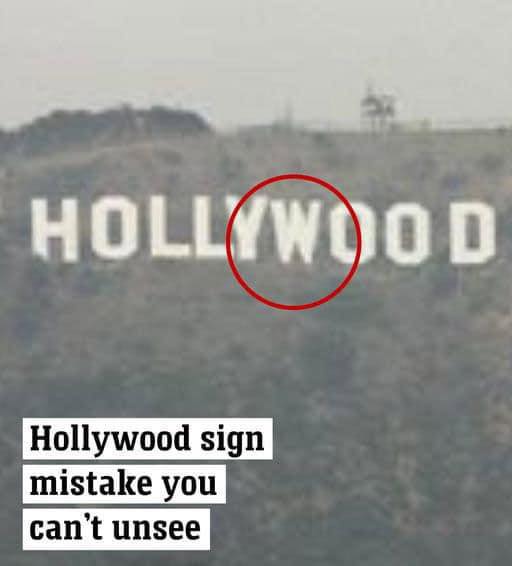Have you ever taken a close look at the Hollywood sign and felt like something was just slightly off? If so, you’re not alone. And if you haven’t noticed anything unusual, you’re about to see what so many people have missed. But be warned—once you catch it, you’ll never be able to unsee it.

A Subtle Quirk in the Hollywood Sign Jeff Zarrinman, chairman of the Hollywood Sign Trust, has long been fascinated by a small but noticeable detail in the iconic Hollywood sign. In an interview with News.com.au, he revealed that once people spot this quirk, they can’t look at the sign the same way again. The issue? It’s all in the “W.”
Take a moment to focus on the shape of the “W” in “Hollywood.” Notice anything odd? If not, here’s a clue: the left gap of the letter forms a much narrower “V” shape compared to the right side.
“I always enjoy pointing this out to people standing in front of it,” Zarrinman shared. “Everyone loves to admire the sign, but almost no one picks up on this little flaw. When I tell them that one of the ‘V’ shapes in the ‘W’ is significantly smaller than the other, they’re completely shocked.”
He continued, “So yes, if you want to call it a mistake, it’s still there for everyone to see—but most people miss it, even if they’ve been staring at the sign for hours. And once they do notice it, they can’t unsee it.”
The History Behind the Hollywood Sign The Hollywood sign has a long and storied past that extends far beyond its imperfect “W.” Its history dates back to 1923, when real estate developer and Los Angeles Times publisher Harry Chandler came up with the idea of a massive sign to draw attention to a new housing development. The goal was simple: create a highly visible advertisement for the neighborhood known as “Hollywoodland.”
For years, the sign served its purpose, attracting prospective buyers and establishing Hollywoodland as an exclusive residential area. But when the Great Depression hit in the 1930s, property sales plummeted, and the development struggled. As financial hardship spread, funds to maintain the sign became scarce.
With no money for upkeep, the sign deteriorated. The lights that once illuminated the letters went dark, and the structure began to decay. By 1944, the Hollywood Chamber of Commerce intervened, recognizing the sign’s cultural significance. In a strategic move, they decided to drop the “land” from “Hollywoodland,” reflecting the area’s shift from a real estate venture to an entertainment powerhouse.
A Fight to Save the Sign Originally built as a temporary promotional piece, the Hollywood sign was never meant to last forever. But by the 1940s, it had already become a beloved symbol of Hollywood and the film industry. The Chamber of Commerce took responsibility for its maintenance, ensuring its preservation.
However, by the 1970s, the sign had fallen into extreme disrepair once again. The Chamber knew they needed to take drastic action. This time, they decided on a complete overhaul—dismantling the sign and rebuilding it from scratch.
To fund the ambitious restoration, Zarrinman led several fundraisers, ultimately raising $250,000 to bring the project to life.
“The sign had a massive following, and the community was eager to help,” Zarrinman said. “In April of 1978, the Chamber launched a ‘Save the Sign Committee’ to preserve this cultural landmark.”
Celebrities Step In to Rescue the Hollywood Sign Saving the Hollywood sign wasn’t just a community effort—it also attracted celebrity support. Big names like Hugh Hefner, Alice Cooper, and the Warner Brothers joined the cause, each sponsoring an individual letter. Hefner, the founder of Playboy, chose the letter “Y,” while rock star Alice Cooper funded the letter “O.”
The involvement of celebrities amplified media attention and energized the public, turning the restoration into a high-profile campaign. Thanks to these efforts, by the end of 1978, the Hollywood sign was restored to its former glory, securing its place as an enduring symbol of the entertainment industry.
A Legacy of Imperfection Today, the Hollywood sign remains one of the most recognized landmarks in the world. But even after its grand restoration, it still carries that subtle imperfection—the asymmetrical “W.” Zarrinman’s anecdote serves as a reminder that even the most famous things can have flaws, and sometimes, those quirks make them even more special.
The Hollywood sign’s journey from a simple real estate advertisement to a globally recognized icon underscores how cultural landmarks evolve in unexpected ways. It wasn’t built to become a symbol of Hollywood’s glamour and mystique—it grew into that role over time, just as Hollywood itself transformed into the entertainment capital of the world.
So next time you find yourself gazing up at the Hollywood sign, take a closer look. Beyond its towering presence and historical significance, there’s a little imperfection that adds character to an already legendary symbol. And once you see it, you’ll never be able to unsee it.





